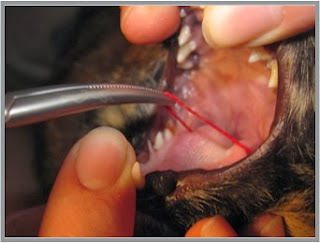“Time is trauma!” How many times have you heard that from the anesthesiologist
or anesthesia technician monitoring your surgical patient? How does it make you
feel when people comment on the duration of your surgery; pressured, annoyed,
even angry? All understandable reactions. But, there is a scientific
basis for that cliché. The longer the tissues are exposed to the air the more
likely to have complications such as excessive inflammation and infection.1
During my residency I was taught that for every hour the incision is open the
rate of infection doubles.2 Studies on human hospitals have found
the clinics with higher case loads tend to have fewer surgical complications than the slower
ones.3
In the 19th century surgical speed was essential
because surgery was done without anesthesia. Rapid surgery was necessary to
decrease pain and mortality. Dr. Robert Liston was famous for being the fastest
surgeon of his time. He could amputate a person’s leg in 2 and ½ minutes! But,
occasionally his intent on being fast led to serious mishaps such as when he
accidentally removed a man’s testicles while amputating his leg, and cutting
off his assistant’s fingers during another lightening fast operation.
Thankfully in modern day surgery we have general anesthesia
and other support systems to minimize morbidity and mortality and eliminate the
need for 2 and ½ minute amputations. But prolonged surgery time still leads to
increased postoperative problems for the patient and takes its toll on the
surgeon. The longer the surgery takes the more likely you and your assistants
will become stressed, tired, hungry, and have full urinary bladders. Tired
surgeons become inefficient, less patient, and less meticulous. Decisions become
more difficult and are made with less confidence. The surgeon loses focus and
direction.
There is a also a stigma to being a slow surgeon. People,
particularly non-surgeons, tend to judge surgical skill by how fast the surgeon
is rather than by the hand skills or the ability to “think on your feet”. Its
not always fair, but it happens.
Performing an operation swiftly is just one of many aspects
of being a good surgeon and actually not the most important one. Speed in
surgery is, although important, somewhat overrated. Patient evaluation, owner
communication, and decision making before
surgery are more important elements to good surgical practice. The decision
making process involves a careful analysis of the patient, its owner, and the
evidence based medicine that is relevant to your patient. The surgeon’s
dedication to these principles trumps having hands that are a blur on the
operating table.
Although being a speedy surgeon is not absolutely essential,
the clinical evidence is clear that shorter operative times result in fewer
postoperative complications. Here are 5 things you can do right now to reduce the time your surgical
patients spend on the operating table:
- Have a plan. Base that plan on a thorough review of all aspects of the patient’s clinical presentation and status. Review the current literature for up to date information on the disorder and the surgical technique. Review anatomy and the steps involved in the procedure. Get advice from others before the surgery, not during. Discuss your plan with your support staff.
- Use good quality instruments and sutures. Have them ready in the operating room. Poor quality tools and materials lead to frustration, stress, and delays.
- Have an assistant surgeon. An assistant saves time by retracting, handing you instruments, cutting sutures, and keeping the instrument table organized. A lot of time is wasted searching for instruments when they are piled up on the table. Veterinary technicians love to scrub in and get close to the action! Let them do it!
- Eliminate distractions. Tell your staff not to bother you while you're in surgery. If a question can wait, save it for later. Limit the number of people in the operating room to reduce noise and commotion. Play soft, pleasant music to keep you relaxed and at ease.
- Don’t force it. You can’t will yourself to be faster. Allow it to happen naturally as you gain experience and repetition with procedures. Experience is a wonderful teacher; you learn how to handle tissues effectively and atraumatically. Your hands will start to flow through the surgery with little wasted motion and less tissue manipulation. Live in the moment and enjoy it.
 |
| A clean, organized instrument table makes surgery more efficient and less frustrating. |
Conclusion
Surgical skill is more about what’s between your ears than
in your hands. Practice your technical skills and always strive to have better hands,
but be a “thinking” surgeon. Learn from your mistakes, keep a positive outlook,
and believe in yourself. Do that, and you will find surgery to be a very
satisfying part of your veterinary career, and your patients will appreciate
your knowledge and skill by having uncomplicated postoperative recoveries.
References
1. Manilich E, Vogel JD, Kiran RP, Church JM, Seyidova-Khoshknabi D, Remzi FH. Key factors associated
with postoperative complications in patients undergoing colorectal surgery. Dis Colon Rectum. 2013 Jan;56(1):64-71.
2. Cruse PJ, Foord R. The epidemiology of wound infection. A 10-year
prospective study of 62,939 wounds. Surg Clin North Am.
1980;60(1):27-40.
3. Talya Salz,
Robert S. Sandler. The
Effect of Hospital and Surgeon Volume on Outcomes for Rectal Cancer Surgery Clinical
Gastroenterology and Hepatology 2008
6:11, pg 1185–1193
Acknowledgement
Thank you to my friend and mentor, Dr. Ronald M. Bright, for teaching me to be a thinking surgeon.










.jpg)


























